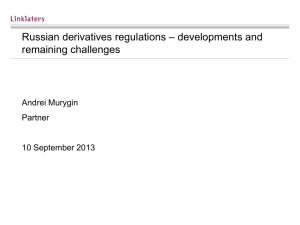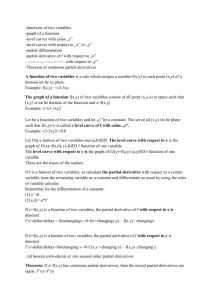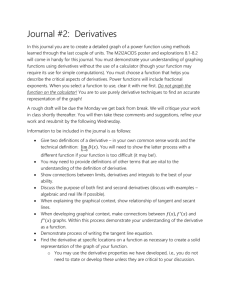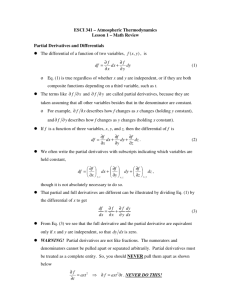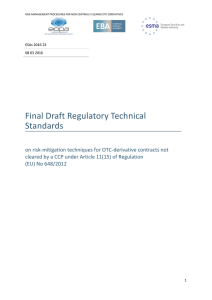Spotlight CPD Quiz Derivatives August 2009
advertisement
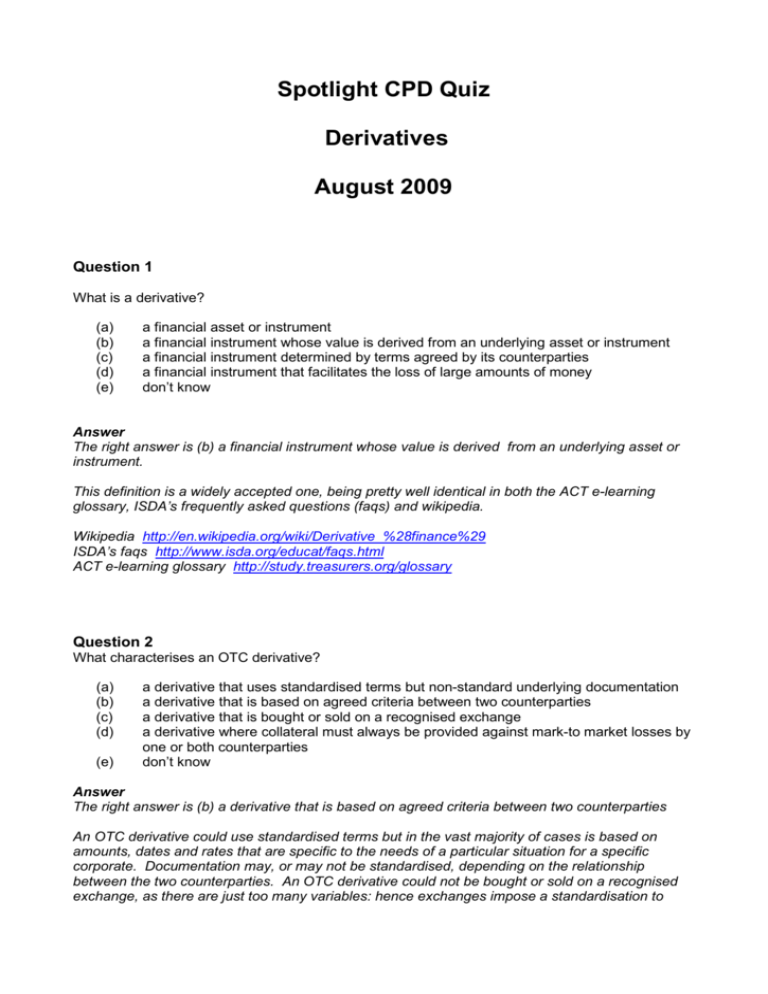
Spotlight CPD Quiz Derivatives August 2009 Question 1 What is a derivative? (a) (b) (c) (d) (e) a financial asset or instrument a financial instrument whose value is derived from an underlying asset or instrument a financial instrument determined by terms agreed by its counterparties a financial instrument that facilitates the loss of large amounts of money don’t know Answer The right answer is (b) a financial instrument whose value is derived from an underlying asset or instrument. This definition is a widely accepted one, being pretty well identical in both the ACT e-learning glossary, ISDA’s frequently asked questions (faqs) and wikipedia. Wikipedia http://en.wikipedia.org/wiki/Derivative_%28finance%29 ISDA’s faqs http://www.isda.org/educat/faqs.html ACT e-learning glossary http://study.treasurers.org/glossary Question 2 What characterises an OTC derivative? (a) (b) (c) (d) (e) a derivative that uses standardised terms but non-standard underlying documentation a derivative that is based on agreed criteria between two counterparties a derivative that is bought or sold on a recognised exchange a derivative where collateral must always be provided against mark-to market losses by one or both counterparties don’t know Answer The right answer is (b) a derivative that is based on agreed criteria between two counterparties An OTC derivative could use standardised terms but in the vast majority of cases is based on amounts, dates and rates that are specific to the needs of a particular situation for a specific corporate. Documentation may, or may not be standardised, depending on the relationship between the two counterparties. An OTC derivative could not be bought or sold on a recognised exchange, as there are just too many variables: hence exchanges impose a standardisation to enable fungibility – the substitutability of one contract for another – so that traders can buy and sell equivalent contracts. Collateral (“margin”) has been used more frequently in recent years. According to the ISDA Margin Survey 2009, quoted in the EU Commission Staff Working Paper, the level of bilateral collateral provisioning stood at 66% by value with cash or government securities being the dominant collateral source. EU Commission Staff Working Paper – Ensuring efficient safe and sound derivatives markets http://ec.europa.eu/internal_market/financial-markets/docs/derivatives/report_en.pdf Question 3 US and EU proposals to improve the operation of the derivatives markets focus on the need to reduce the systemic risk from a major derivative market maker defaulting, thereby leaving other derivative investors with unmatched positions. This potential problem is thought to be aggravated by the opacity of many OTC derivatives because other market participants do not know the impact that such a default might have on them of their existing counterparties. What is the principal proposal among the many put forward is intended to overcome this systemic risk? (a) (b) (c) (d) (e) all major derivative dealers must maintain much higher capital requirements all derivatives must be authorised and approved by a recognised exchange in the US or the EU all eligible derivatives to be cleared by a central counterparty similar to an exchange clearing house OTC derivatives must conform to exchange standard contract terms Don’t know Answer The right answer is (c) all eligible derivatives to be cleared by a central counterparty similar to an exchange clearing house. The key word here is “eligible”. There is debate regarding how eligibility is to be decided – whether by regulation or by the central counterparty (CCP) responsible for clearing. Among the incentives being discussed to make the use of these eligible derivatives more attractive are the zero-risk weighting of derivatives cleared by a CCP, thus reducing the cost and the possibility of making it a legal requirement. EU Commission Staff Working Paper, Consultation Document - Possible initiatives to enhance the resilience of OTC Derivatives Markets: http://ec.europa.eu/internal_market/consultations/docs/2009/derivatives/derivatives_consultation.p df Also discussed on ACT website: http://www.treasurers.org/OTCderivatives Question 4 Many commentators have attributed the recent financial crisis to poor lending, poor risk management, derivatives generally and credit derivatives in particular. Which of the following categories of OTC derivatives forms the largest market sector by value in 2009? (a) (b) (c) (d) (e) interest rate contracts foreign exchange contracts credit default swaps equity linked contracts don’t know Answer The right answer is (a) interest rate contracts According to BIS data, in 2009 interest rate contracts accounted for 71% of the OTC derivatives market. Foreign exchange contracts accounted for roughly 8%; credit default swaps accounted for roughly 7%, while equity linked contracts accounted for around 1%. It is clear that together interest rate and foreign exchange contracts account for close to 80% of the OTC derivatives market. These are also the most transparent contracts regarding pricing and market value as there are readily accessible markets providing quotes continuously. OTC interest rate derivatives outnumber their exchange-traded equivalents by around 10 to 1. BIS data quoted in EU Commission Staff Working Paper – Ensuring efficient safe and sound derivatives markets – page 20 and page 30. http://ec.europa.eu/internal_market/financial-markets/docs/derivatives/report_en.pdf Question 5 The increased use of collateral to offset bilateral counterparty risk has been proposed in the EU consultation document on the potential for enhancing the resilience of OTC derivatives markets. Imagine the following situation. ABC plc enters an OTC interest rate swap to hedge against the risk of rising interest rates on its floating rate borrowings. As interest rates fall ABC is still happy that it followed such a prudent hedging strategy and that its cashflow is protected from the consequences of a possible rate rise. What is the cash impact of the rate fall on ABC if, under the terms of the swap, cash collateral (“margin”) is required to offset any adverse movements in market value? (a) There is no impact on ABC (b) ABC must provide an immediate cash amount to cover the change in value of the swap (c) The bank counterparty must provide an immediate cash amount to cover the change in value of the swap (d) ABC receives cash collateral from its bank counterparty (e) Don’t know Answer The right answer is (b) ABC must provide an immediate cash amount to cover the change in value of the swap. As rates fall, ABC sees the swap as having a negative value – that value being the obligation to continue to deliver its side of the swap contract (the fixed rate) even though rates have changed. The cash collateral covers the counterparty’s risk. Interestingly the impact on ABC, having taken hedging action to avoid an extra cash demand through rising rates, now has an extra cash demand due to falling rates – it is the ‘out-of-themoney’ counterparty and so has to put up collateral. This cash call would be greater with increasing length of the swap contract. If the rates had moved the other way, the counterparty would have provided margin to ABC, but ABC would have to treat this as “hot money”, liable to flow out again with no notice, and so not useable in its business. If you don’t expect the floating rate to go negative, a rate of zero could be seen as setting a cap on the fixed payer’s margin liability. On the other hand, the floating rate payer’s margin payment is potentially unbounded as there is no upper limit on interest rates. ACT background information on the proposals for regulation of OTC derivatives July 2009 (updated 28 August 2009 with the ACT’s response to the European Commission’s consultation) is at http://www.treasurers.org/OTCderivatives/background. Question 6 What are the potential drawbacks for corporates if all derivatives were required to be standardised and exchange traded? (a) the hedge would be less likely to match the risk represented by the underlying exposure (b) the hedge is less likely to be capable of proving its effectiveness under hedge accounting rules, thereby not qualifying as a hedge (c) the hedge is potentially a source of unpredictable – and unhedgeable – margin calls and therefore an additional risk in its own right. (d) All of the above (e) Don’t know Answer The right answer is (d) all of the above The most serious potential issue for the corporate is the possible unpredictable immediate cash outflows of collateral (“margin”) monies when its previous OTC counterparty had been happy not to receive collateral. Administration and accounting of margin is a small extra burden for the corporate, of course. If a corporate attempts to hedge individual risks rather than categories of risks, then the use of exchange traded hedges makes matching of a risk with a hedge much less likely; hedge accounting harder to achieve due to the difficulty in proving hedge effectiveness. The OTC market has evolved in the way it has for good reasons; if exchange traded instruments worked as well for all corporates, then the OTC market would probably never have gained ground. Of course some, mainly large, companies do use some types of exchange traded and centrally cleared derivatives and find that works well for them. The systemic risk the authorities are trying to deal with mostly arises in trading between financial counterparties: non-financial corporates are not really the main target of the proposed regulation but may suffer “collateral damage”.




